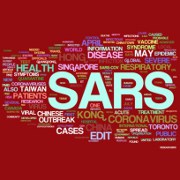 Photo: Getty Images
Photo: Getty Images
In February 2003, a viral respiratory illness known as severe acute respiratory syndrome (SARS) was first reported in Asia. SARS is caused by a coronavirus. A coronavirus is an airborne virus.
According to the National Institute of Allergy and Infectious Disease, "Previously identified human coronaviruses (named for their spiky, crown-like appearance) were known to cause only mild respiratory infections."
The Centers for Prevention and Disease Control (CDC) stated, "Coronaviruses are a group of viruses that have a halo or crown-like (corona) appearance when viewed under a microscope. These viruses are a common cause of mild to moderate upper-respiratory illness in humans and are associated with respiratory, gastrointestinal, liver and neurologic disease in animals."
According to the Centers for Prevention and Disease Control (CDC) symptoms of SARS include:
• A high fever (temperature greater than 100.4°F)
• Headache
• An overall feeling of discomfort
• Body aches
• Mild respiratory symptoms
• Ten to 20 percent of patients may develop diarrhea
• After 2 to 7 days, patients may develop a dry cough
• Most patients develop pneumonia
The typical incubation period for SARS, the time period between initial exposure to the sign of first symptoms, is two to seven days. However, some patients experienced a 10-day incubation period.
Internationally, more than 8,098 people became ill with severe acute respiratory syndrome. The World Health Organization (WHO) stated a total of 774 people died because of the SARS 2003 outbreak. According to the CDC, the illness spread to more than two dozen countries in North America, South America, Europe, and Asia before the SARS global outbreak of 2003 was contained.
The CDC also stated, "In the United States, only eight people had laboratory evidence of SARS-CoV infection. All of these people had traveled to other parts of the world with SARS. SARS did not spread more widely in the community in the United States."
SARS is spread by close person-to-person contact. Medical experts believe the coronavirus is spread through the respiratory droplets of an individual infected with severe acute respiratory syndrome.
For example, when a SARS infected person sneezes or coughs their droplets are propelled into the air and can spread up to three feet. The droplets can land on anyone who is close proximity. The droplets generally land on the mucous membranes of the eyes, nose or mouth of anyone nearby.
A person can become infected with SARS if they touch an infected or contaminated surface and then transmit the virus by touching their nose, mouth or eyes.
If you believe you are infected with SARS, you doctor can conduct a viral culture to detect the SARS virus. Also, serologic testing and a reverse transcription polymerase chain reaction (RT-PCR) test can also detect the SARS virus.
Antibiotics are ineffective for the treatment of SARS. However, the CDC recommends "that patients with SARS receive the same treatment that would be used for a patient with any serious community-acquired atypical pneumonia."
Currently, there are no reported cases of SARS.
References:
Severe Acute Respiratory Syndrome (SARS). National Institute of Allergy and Infectious Diseases Home Page. Retrieved November 14, 2011, from http://www.niaid.nih.gov/topics/sars/Pages/Default.aspx.
CDC | Fact Sheet: Basic Information About SARS. Centers for Disease Control and Prevention. Retrieved November 14, 2011, from http://www.cdc.gov/ncidod/sars/factsheet.htm.
CDC | Frequently Asked Questions About SARS. Centers for Disease Control and Prevention. Retrieved November 14, 2011, from http://www.cdc.gov/ncidod/sars/faq.htm.
Severe Acute Respiratory Syndrome: MedlinePlus. National Library of Medicine - National Institutes of Health. Retrieved November 14, 2011, from http://www.nlm.nih.gov/medlineplus/severeacuterespiratorysyndrome.html.
Reviewed November 14, 2011
by Michele Blacksberg RN
Edited by Jody Smith





Add a CommentComments
There are no comments yet. Be the first one and get the conversation started!